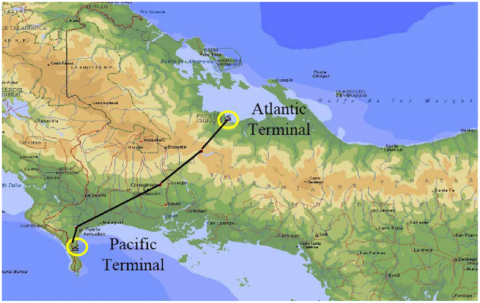The Transpanama Pipeline (TPP) currently ships up to 600 Mb/d of crude from the Atlantic coast of Panama to the Pacific. The pipeline was originally built to facilitate Alaskan crude shipments to the US Gulf Coast but was reversed in 2009 to move Atlantic basin crudes to South American and Far East markets without going through the Panama canal. Could the TPP be utilized to move US crude production from the Gulf Coast to West Coast refineries? Today we review that possibility.
History
The TPP is an 81 mile crude oil pipeline that runs across Panama from the Port of Chiriqui Grande, Bocas del Toro on the Atlantic (Caribbean) coast to the port of Charco Azul on the Pacific coast (see map below). The TPP was opened in 1982 as an alternative to the Panama Canal, to carry crude oil from the Pacific to the Atlantic Ocean. The primary purpose was to ship Alaska North Slope (ANS) crude transported down the Pacific coast to Panama from Valdez, AK to US Gulf Coast refineries. Between 1982 and 1996 the pipeline transported 2.7 billion Bbl of ANS to Gulf Coast refineries. The pipeline was then closed in 1996 as Alaskan crude volumes declined (see After the Oil Rush). In 2003, the TPP was re-opened to move Ecuadorian crude from the Pacific to Gulf Coast refineries.
Source: Tesoro Presentation (Click to Enlarge)
In 2008, pipeline owner Petroterminal de Panama, S.A. signed an agreement with BP to upgrade the pipeline and reverse it’s direction to flow from the Atlantic to the Pacific. The upgrading included building an additional 5 MMBbl of storage at terminals at either end of the pipeline. After the reversal, Petroterminal signed long-term (7 year) commitments with BP and Tesoro for pipeline capacity and storage utilization. BP initially committed to ship 65 Mb/d in 2008 and lease 5 MMBbl of storage but increased their commitment to 100 Mb/d in a 2012 agreement. Tesoro committed to shipping 107 Mb/d and leasing 4.4 MMBbl of storage under a 2009 agreement.
The Government of Panama (40 percent), Swiss oil trader Gunvor (17 percent) and the pipeline operator, Northville Industries, own Petroterminal. The three companies that currently own capacity on the pipeline are BP, Tesoro and Gunvor. Current capacity is 600 Mb/d. There is little public information available about the flow of oil but in 2012 Argus reported that BP was shipping 300 Mb/d and Petroterminal has reported a 4-fold increase in shipments since 2010.
Significance
The TPP route reduces transport time and shipping costs between Atlantic and Pacific Coast ports by avoiding a trip around Cape Horn at the tip of South America. The pipeline competes directly on this route with the Panama Canal although the latter has some disadvantages. The Canal has restrictions that limit maximum vessel size to “Panamax” capacity of 50 thousand MT or about 380 MBbl of light sweet crude. The Panama Canal has also been subject to periodic delays from traffic congestion. As we previously explained in September 2012 (see Panama Tailored to Fit Larger Vessels), the Panama Canal is currently being expanded so that by 2015 larger vessels including oil tankers carrying 600 MBbl will be able to pass through. However, the TPP provides shippers with a more flexible alternative because port terminals at either end of the pipeline can berth very large crude carrier (VLCC) vessels that carry up to 1 MMBbl. That means a VLCC on the Atlantic side carrying crude from (say) North Africa or Europe can offload crude to the TPP to be reloaded onto another VLCC on the Pacific side. Economies of scale in moving crude by VLCC make this an attractive alternative to using smaller vessels and facing possible delays using the Canal.
Large onshore storage at both ends of the TPP also provide for crude oil blending and the optimizing of crude distribution to West Coast refiners. Different crudes can be blended to meet refinery needs at the PTT terminals and VLCC cargoes delivered at the Atlantic end can be broken down into smaller batches for shipment to West Coast refineries that do not have adequate storage to cope with VLCC size shipments.
The primary significance of the TPP is that it facilitates the increased flow of crude between Atlantic and Pacific markets. The pipeline makes it feasible to ship a variety of Latin American and West African crudes to West Coast refineries. For example it cuts the shipping distance from Nigeria to Los Angeles by about 3,400 miles – reducing the journey time by about 30 days. Other improved journey times include those for Venezuelan crude to Far East markets (14 days faster), Russia to West Coast South America (11 days faster) and North Sea to US West Coast (35 days faster).



